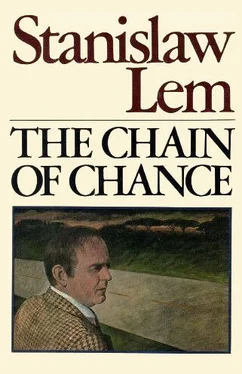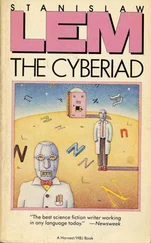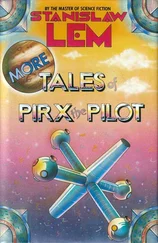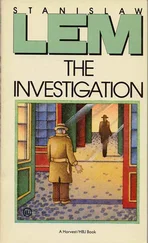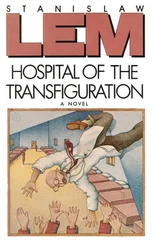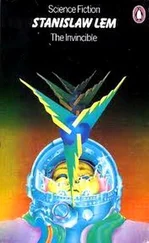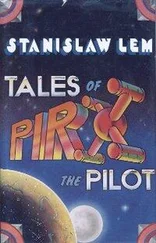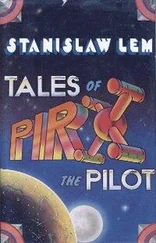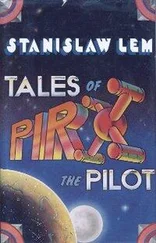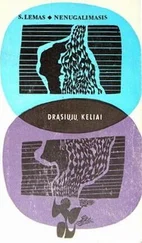Stanislaw Lem - The Chain of Chance
Здесь есть возможность читать онлайн «Stanislaw Lem - The Chain of Chance» весь текст электронной книги совершенно бесплатно (целиком полную версию без сокращений). В некоторых случаях можно слушать аудио, скачать через торрент в формате fb2 и присутствует краткое содержание. Город: New York, ISBN: , Издательство: Harcourt Brace Jovanovich, Жанр: Фантастика и фэнтези, на английском языке. Описание произведения, (предисловие) а так же отзывы посетителей доступны на портале библиотеки ЛибКат.
- Название:The Chain of Chance
- Автор:
- Издательство:Harcourt Brace Jovanovich
- Жанр:
- Год:неизвестен
- Город:New York
- ISBN:9780151165896
- Рейтинг книги:3 / 5. Голосов: 1
-
Избранное:Добавить в избранное
- Отзывы:
-
Ваша оценка:
- 60
- 1
- 2
- 3
- 4
- 5
The Chain of Chance: краткое содержание, описание и аннотация
Предлагаем к чтению аннотацию, описание, краткое содержание или предисловие (зависит от того, что написал сам автор книги «The Chain of Chance»). Если вы не нашли необходимую информацию о книге — напишите в комментариях, мы постараемся отыскать её.
The Chain of Chance — читать онлайн бесплатно полную книгу (весь текст) целиком
Ниже представлен текст книги, разбитый по страницам. Система сохранения места последней прочитанной страницы, позволяет с удобством читать онлайн бесплатно книгу «The Chain of Chance», без необходимости каждый раз заново искать на чём Вы остановились. Поставьте закладку, и сможете в любой момент перейти на страницу, на которой закончили чтение.
Интервал:
Закладка:
After establishing that all the accidents had occurred while Coburn was on his way back from the health spa, the assistant then proceeded to the Vittorinis. Because of the American’s generosity toward the staff, they had no trouble remembering him. There had been nothing extraordinary about his behavior except that lately he had seemed more pressed for time, frequently ignoring the bath attendant’s warning to wait ten minutes and dry off before going outside. Such meager findings failed to satisfy the investigating officer, who, in a fit of enthusiasm and inspiration, undertook a review of the establishment’s books, which contained a record of payments made by all its bathing customers as well as those requiring hydrotherapeutic treatment.
Since the middle of May a total of ten Americans had visited the Vittorini spa, four of whom, like Coburn, had paid for a season pass (one could buy a one-, two-, three-, or four-week pass) but failed to show up after the eighth or ninth day. Not that there was anything particularly unusual about that, since any one of them might have been called away unexpectedly and thus had to forgo whatever refund he had coming. But now that the assistant knew their names, he decided to follow up his investigation. When later asked why he had limited himself to American citizens, he was not able to give a clear-cut answer. At one point he claimed he had hit on the idea of an American connection after learning that the police had recently smashed a narcotics ring trafficking in heroin between Naples and the States; on another occasion he said he had restricted himself to Americans for the simple reason that Coburn had been an American.
Of the four who failed to take full advantage of their subscriptions, the first, Arthur I. Holler, an attorney from New York, had suddenly left town after being notified of his brother’s death. He was now back in his native city. Married and thirty-six years of age, he was employed as legal consultant for a large advertising agency.
The remaining three showed a certain physical resemblance to Coburn. In each case the person involved was a single male, between forty and fifty years of age, reasonably well-to-do, and invariably a patient of Dr. Giono. One of the Americans, Ross Brunner, Jr., had stayed at the same hotel as Coburn, the Savoy; the other two, Nelson C. Emmings and Adam Osborn, at boardinghouses that offered more modest accommodations but were also situated by the bay. Photos obtained from the States established beyond any doubt the physical resemblances of the missing: athletic builds, a tendency toward obesity, signs of balding, obvious attempts to camouflage same. Though Coburn’s body was subjected to a thorough examination in the Institute of Forensic Medicine and showed no traces of violence, and though the cause of death was attributed to accidental drowning due to a muscle cramp or physical exhaustion, the police commission recommended in favor of continuing the investigation. Further inquiry was made into the fate of the other three Americans, and it was soon learned that Osborn had left Rome without notice, that Emmings had flown to Paris, and that Brunner had gone insane. Brunner’s case was already a matter of police record. Though originally a guest of the Savoy, he had been lying in the city hospital since early May. He was an automobile designer from Detroit. During the first week of his stay in Naples he was a model of good behavior, spending mornings at the solarium and evenings at the Vittorini spa, except on Sundays, when he made a habit of going on various sightseeing tours. Since his trips were all arranged through a local travel agency, a branch of which was located in the Savoy, it was easy to establish his itineraries. Among the places he visited were Pompeii and Herculaneum; he took no sea baths, since his doctor had advised against it because of his kidney stones. Even though he had paid in advance, he canceled a trip to Anzio on the day before it was scheduled to leave; for the preceding two days his behavior had also been somewhat erratic. He gave up walking altogether, demanding his car even when his destination was only two blocks away, which turned out to be a nuisance because a new parking lot was then under construction and cars belonging to the guests had to be squeezed into a neighboring lot.
Brunner refused to pick up the car himself and insisted that it be brought around by one of the hotel staff; this gave rise to several altercations. That Sunday, he not only passed up the sightseeing tour but also failed to show up for supper, ordering through room service instead. No sooner did the waiter set foot inside the door than Brunner jumped him from behind and tried to strangle him. In the scuffle he broke one of the waiter’s fingers before jumping out the window, suffering a broken leg and a fractured pelvis in the two-story fall. At the hospital he was diagnosed as having suffered—in addition to the multiple fractures—a mental blackout caused by an attack of schizophrenia. The hotel management was understandably anxious to hush up the whole affair. It was this incident in particular that prompted the commission’s decision—following the death of Coburn—to widen the scope of the inquiry. The case now came under general review. The question arose whether Brunner had in fact jumped from the window, or whether he had been pushed. Yet no evidence could be found to challenge the waiter’s credibility. He happened to be an elderly man with no criminal record.
Brunner remained in the hospital, not because of his mental condition, which gradually improved, but because of complications arising from the mending of his hip bone, while a relative who was supposed to come for him from the States kept postponing his visit. Finally, a prominent physician diagnosed Brunner’s illness as insanity caused by an acute psychotic seizure of unknown etiology: the investigation had reached a dead end.
The second American, Adam Osborn, a middle-aged bachelor with a degree in economics, had driven an Avis rental car from Naples to Rome on June 5. In his hurry to leave the hotel, he had left behind such personal items as an electric razor, several brushes, a chest expander, and a pair of slippers. The management of the Savoy, wishing to forward his things, phoned the hotel in Rome where Osborn had made a reservation but was told that no one had checked in under that name. The hotel soon gave up trying to track down its capricious guest, but a more thorough investigation revealed that Osborn had never reached his destination. At the Avis rental agency the detective learned that the rental car, an Opel Record, had been found parked in the emergency lane in the vicinity of Zagarolo, just outside Rome—in perfect running condition and with Osborn’s luggage still intact. Since the Opel belonged to and was registered with the firm’s fleet in Rome—it had been delivered to Naples by a French tourist en route from Rome—the agency notified the Rome police. Osborn’s things were seized, and the police in Rome decided to launch a separate investigation of their own when Osborn was found at dawn the following day—dead. He had been run over by a car on the Strada del Sole, at the Palestrina exit, roughly nine kilometers from where the rental car had been abandoned.
The assumption was that for no apparent reason he had climbed out of his car and started walking along the shoulder of the road until reaching the first exit, where he became the victim of a hit-and-run accident. The police were able to reconstruct the exact sequence of events, because Osborn had accidentally spilled some eau de cologne on the car’s rubber matting; a police dog had little trouble in following the scent, even though it had rained during the night. It seems Osborn had kept to the side of the road the whole time except when the highway cut through a hill, at which point he had left the concrete road and climbed to the top of the nearest knoll. After a while he returned to the road and resumed hiking. When he came to the exit ramp, he went zigzagging down the road like a drunk. He died instantly of a fractured skull. The road was spotted with blood and strewn with splinters of headlight glass when they found the body. So far the police in Rome had been unable to track down the hit-and-run driver. The most curious thing of all was that, despite the heavy afternoon traffic, Osborn had been able to walk a distance of nine kilometers on the highway without being noticed. If nothing else, he should have attracted the attention of a highway patrol car, since pedestrians are not allowed on the highway. The explanation came a few days later, when a golf bag was found dumped early one morning in front of a police station and identified as Osborn’s through the name engraved on the handgrips. This led to speculation that he might have been carrying the golf bag over his shoulder and that, because the clubs were covered by a hood and he himself was wearing a pair of jeans and a short-sleeved shirt, the passing drivers might have mistaken him for a member of the road crew. The clubs were probably left lying at the scene of the accident; whoever picked them up must have read about the investigation in the papers, panicked at the thought of becoming personally implicated in a criminal matter, and got rid of them.
Читать дальшеИнтервал:
Закладка:
Похожие книги на «The Chain of Chance»
Представляем Вашему вниманию похожие книги на «The Chain of Chance» списком для выбора. Мы отобрали схожую по названию и смыслу литературу в надежде предоставить читателям больше вариантов отыскать новые, интересные, ещё непрочитанные произведения.
Обсуждение, отзывы о книге «The Chain of Chance» и просто собственные мнения читателей. Оставьте ваши комментарии, напишите, что Вы думаете о произведении, его смысле или главных героях. Укажите что конкретно понравилось, а что нет, и почему Вы так считаете.
